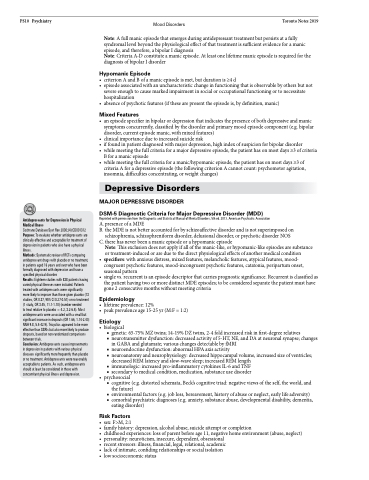Page 1174 - TNFlipTest
P. 1174
PS10 Psychiatry
Mood Disorders Toronto Notes 2019
Note: A full manic episode that emerges during antidepressant treatment but persists at a fully syndromal level beyond the physiological effect of that treatment is sufficient evidence for a manic episode, and therefore, a bipolar I diagnosis
Note: Criteria A-D constitute a manic episode. At least one lifetime manic episode is required for the diagnosis of bipolar I disorder
Hypomanic Episode
• criterionAandBofamanicepisodeismet,butdurationis≥4d
• episodeassociatedwithanuncharacteristicchangeinfunctioningthatisobservablebyothersbutnot
severe enough to cause marked impairment in social or occupational functioning or to necessitate
hospitalization
• absenceofpsychoticfeatures(ifthesearepresenttheepisodeis,bydefinition,manic)
Mixed Features
• anepisodespecifierinbipolarordepressionthatindicatesthepresenceofbothdepressiveandmanic symptoms concurrently, classified by the disorder and primary mood episode component (e.g. bipolar disorder, current episode manic, with mixed features)
• clinicalimportanceduetoincreasedsuiciderisk
• iffoundinpatientdiagnosedwithmajordepression,highindexofsuspicionforbipolardisorder
• whilemeetingthefullcriteriaforamajordepressiveepisode,thepatienthasonmostdays≥3ofcriteria
B for a manic episode
• whilemeetingthefullcriteriaforamanic/hypomanicepisode,thepatienthasonmostdays≥3of
criteria A for a depressive episode (the following criterion A cannot count: psychomotor agitation, insomnia, difficulties concentrating, or weight changes)
Depressive Disorders
MAJOR DEPRESSIVE DISORDER
DSM-5 Diagnostic Criteria for Major Depressive Disorder (MDD)
Reprinted with permission from the Diagnostic and Statistical Manual of Mental Disorders, 5th ed. 2013. American Psychiatric Association
A. presence of a MDE
B. the MDE is not better accounted for by schizoaffective disorder and is not superimposed on
schizophrenia, schizophreniform disorder, delusional disorder, or psychotic disorder NOS C. there has never been a manic episode or a hypomanic episode
Note: This exclusion does not apply if all of the manic-like, or hypomanic-like episodes are substance
or treatment-induced or are due to the direct physiological effects of another medical condition • specifiers: with anxious distress, mixed features, melancholic features, atypical features, mood-
congruent psychotic features, mood-incongruent psychotic features, catatonia, peripartum onset,
seasonal pattern
• singlevs.recurrentisanepisodedescriptorthatcarriesprognosticsignificance.Recurrentisclassifiedas
the patient having two or more distinct MDE episodes; to be considered separate the patient must have gone 2 consecutive months without meeting criteria
Epidemiology
• lifetime prevalence: 12%
• peakprevalenceage15-25yr(M:F=1:2)
Etiology
• biological
■ genetic: 65-75% MZ twins; 14-19% DZ twins, 2-4 fold increased risk in first-degree relatives
■ neurotransmitter dysfunction: decreased activity of 5-HT, NE, and DA at neuronal synapse; changes
in GABA and glutamate; various changes detectable by fMRI
■ neuroendocrine dysfunction: abnormal HPA axis activity
■ neuroanatomy and neurophysiology: decreased hippocampal volume, increased size of ventricles;
decreased REM latency and slow-wave sleep; increased REM length ■ immunologic: increased pro-inflammatory cytokines IL-6 and TNF ■ secondary to medical condition, medication, substance use disorder
• psychosocial
■ cognitive (e.g. distorted schemata, Beck’s cognitive triad: negative views of the self, the world, and
the future)
■ environmental factors (e.g. job loss, bereavement, history of abuse or neglect, early life adversity)
■ comorbid psychiatric diagnoses (e.g. anxiety, substance abuse, developmental disability, dementia,
eating disorder)
Risk Factors
• sex: F>M, 2:1
• familyhistory:depression,alcoholabuse,suicideattemptorcompletion
• childhoodexperiences:lossofparentbeforeage11,negativehomeenvironment(abuse,neglect) • personality: neuroticism, insecure, dependent, obsessional
• recentstressors:illness,financial,legal,relational,academic
• lackofintimate,confidingrelationshipsorsocialisolation
• lowsocioeconomicstatus
Antidepressants for Depression in Physical Medical Illness
Cochrane Database Syst Rev 2000;(4):CD001312 Purpose: To evaluate whether antidepressants are clinically effective and acceptable for treatment of depression in patients who also have a physical illness.
Methods: Systematic review of RCTs comparing antidepressant drugs with placebo or no treatment, in patients aged 16 years and over who have been formally diagnosed with depression and have a specified physical disorder.
Results: Eighteen studies with 838 patients having varied physical illnesses were included. Patients treated with antidepressants were significantly more likely to improve than those given placebo (13 studies, OR 0.37, 95% CI 0.27-0.51) or no treatment (1 study, OR 3.45, 11.1-1.10) (number needed
to treat relative to placebo = 4.2, 3.2-6.4). Most antidepressants were associated with a small but significant increase in dropouts (OR 1.66, 1.14-2.40; NNH 9.8, 5.4-42.9). Tricyclics appeared to be more effective than SSRIs but also more likely to produce dropouts, based on non-randomized comparisons between trials.
Conclusion: Antidepressants cause improvements in depression in patients with various physical diseases significantly more frequently than placebo or no treatment. Antidepressants were reasonably acceptable to patients. As such, antidepressants should at least be considered in those with concomitant physical illness and depression.


